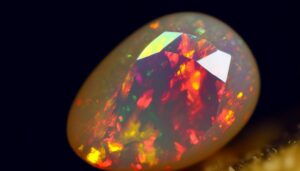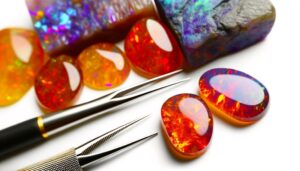10 Key Differences: Fire Opal vs Ethiopian Opal
When comparing fire opals and Ethiopian opals, you'll find they differ greatly in origin, color, and structure. Fire opals form in volcanic regions like Mexico, showcasing vibrant reds, oranges, and yellows due to iron inclusions.
In contrast, Ethiopian opals develop in sedimentary deposits, known for their broad spectrum play-of-color from light diffraction. Fire opals often exhibit higher transparency and durability with a Mohs hardness of 6 to 6.5.
Ethiopian opals, hydrophane in nature, can vary in clarity and are slightly less durable. If you're curious about market trends and popular uses, there's more to explore.
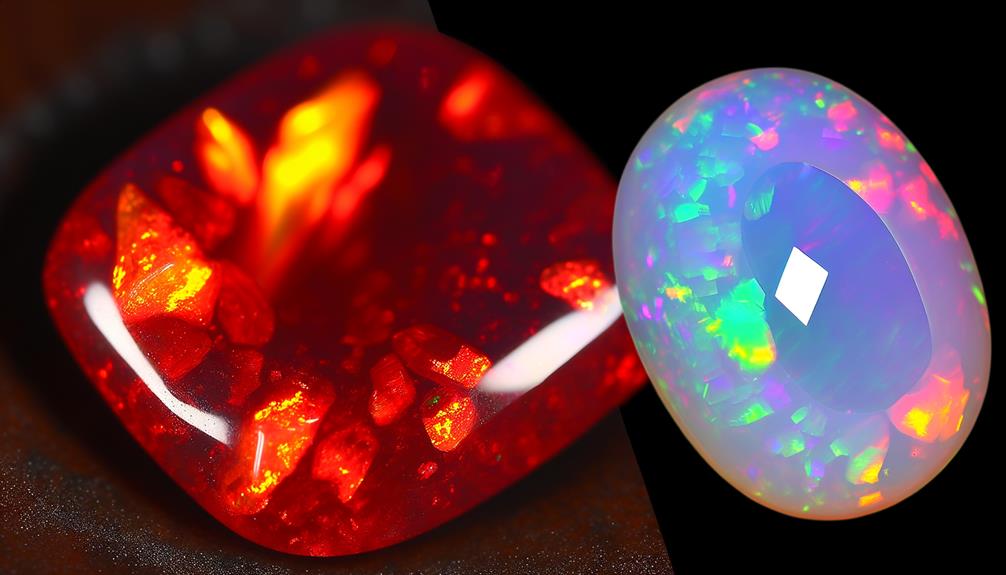
Key Takeaways
- Origin: Fire opals form in volcanic regions like Mexico, while Ethiopian opals develop in sedimentary deposits.
- Color: Fire opals feature reds, oranges, and yellows; Ethiopian opals display a broader spectrum with play-of-color.
- Transparency: Fire opals are often more transparent; Ethiopian opals can vary from opaque to translucent.
- Durability: Fire opals are slightly harder and more durable (Mohs 6-6.5) than Ethiopian opals (Mohs 5.5-6.5).
- Market Value: Fire opals typically have higher market value due to consistent demand for their intense hues and durability.
Origin and Formation

Both fire opals and Ethiopian opals originate from distinct geological environments. Fire opals form in volcanic regions where silica-rich fluids fill cavities in the rock, eventually cooling and solidifying into fire opals. These opals are often found in areas with significant volcanic history, like Mexico.
Ethiopian opals, on the other hand, develop in sedimentary deposits where water percolates through layers of sandstone and claystone, depositing silica spheres over time. This process creates the hydrophane characteristic, making Ethiopian opals highly absorptive.
Understanding these formation processes helps you appreciate the geological intricacies that result in their unique structures and properties. These opals are distinct from each other yet equally fascinating.
Color Variations
Fire opals and Ethiopian opals exhibit diverse color variations, ranging from vivid reds and oranges in fire opals to the kaleidoscopic play-of-color seen in Ethiopian opals. Fire opals primarily display warm hues due to iron inclusion. In contrast, Ethiopian opals exhibit a broader spectrum, showcasing a play-of-color phenomenon caused by the diffraction of light within their silica structure.
| Opal Type | Color Variations |
|---|---|
| Fire Opal | Reds, Oranges, Yellows |
| Ethiopian Opal | All colors, with play-of-color (rainbow effect) |
| Cause of Color | Iron inclusions (Fire Opal) |
| Cause of Play-of-Color | Light diffraction in silica (Ethiopian Opal) |
Understanding these differences enhances your appreciation for each type's unique beauty. Fire opals offer a consistent, fiery palette, while Ethiopian opals captivate with their dynamic color shifts.
Transparency and Clarity
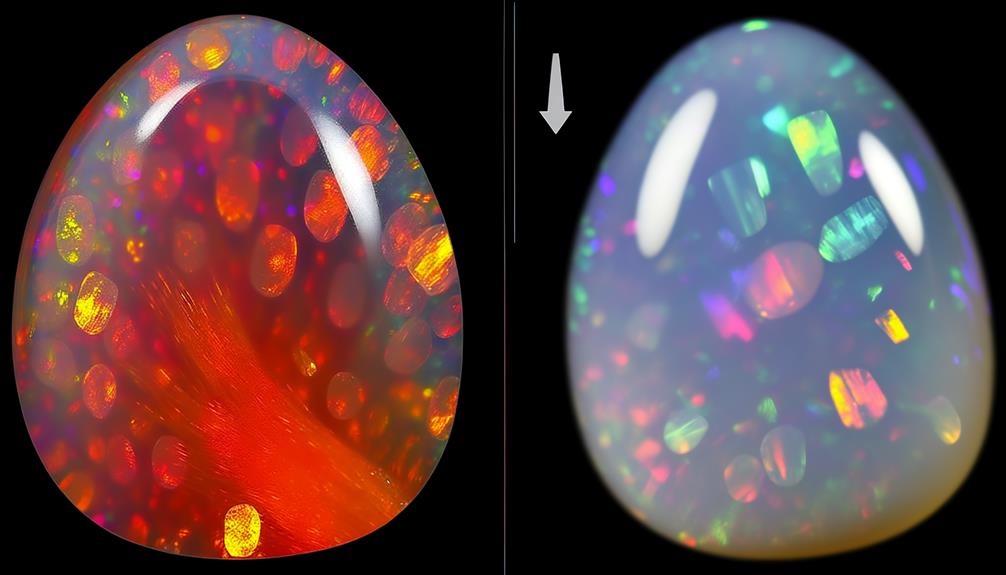
While appreciating their color variations, you should also consider the differences in transparency and clarity between fire opals and Ethiopian opals.
Fire opals often show a higher level of transparency, ranging from slightly see-through to nearly completely see-through, which allows light to pass through the stone more freely. This transparency can enhance the stone's inherent vibrancy.
In contrast, Ethiopian opals usually exhibit a more opaque structure, although they can still range from slightly see-through to opaque. The clarity in Ethiopian opals can be affected by inclusions and fractures, which might be more visible due to their opacity.
Understanding these differences in transparency and clarity is important for accurately evaluating the quality and visual appeal of each type of opal.
Play-of-Color
When evaluating the play-of-color in opals, you'll notice that Ethiopian opals exhibit a more vibrant and diverse spectral display compared to the often more subdued and singular color flashes of fire opals. Ethiopian opals showcase a broad range of colors, including intense reds, greens, blues, and purples, due to their unique internal silica sphere structure. These colors can appear simultaneously, creating a mesmerizing effect.
In contrast, fire opals typically display a dominant warm hue, such as orange or red, with less frequent and less varied color flashes. This limited play-of-color in fire opals results from their different formation environment and composition. Understanding these distinctions helps you appreciate the uniqueness of each type of opal.
Hardness and Durability
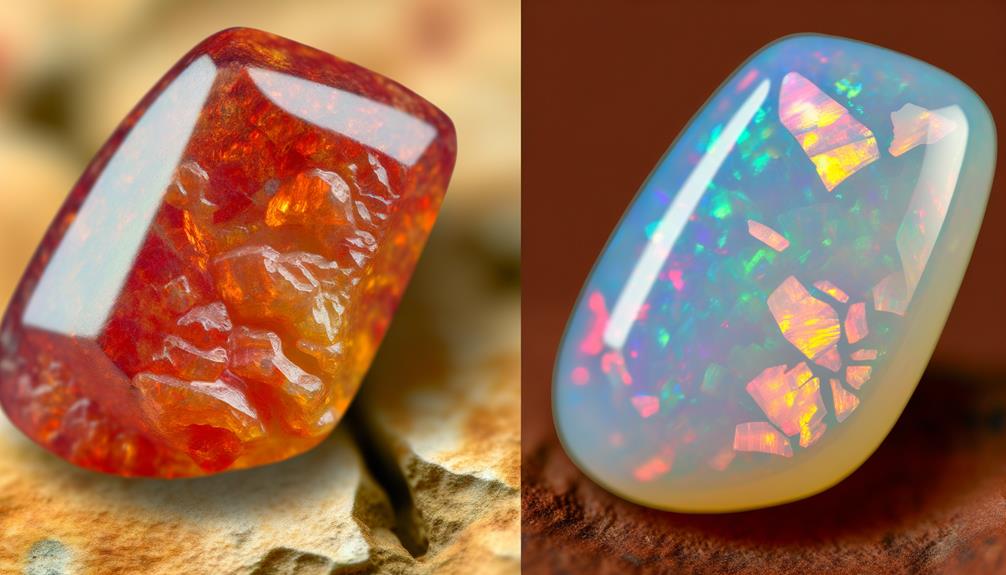
Ethiopian opals, with a Mohs hardness rating of 5.5 to 6.5, are generally less durable than fire opals, which typically rate slightly higher at 6 to 6.5. This slight difference in hardness means Ethiopian opals are more prone to scratching and chipping.
Fire opals, while still relatively soft compared to other gemstones, offer better resistance to abrasion. When you consider durability, Ethiopian opals also tend to have higher water content, making them more susceptible to cracking and crazing over time.
Fire opals, in contrast, are more stable under varying environmental conditions. If you're prioritizing longevity in your jewelry, fire opals might be the better choice due to their higher resistance to wear and environmental stressors.
Common Treatments
Both fire opals and Ethiopian opals often undergo treatments to enhance their color and durability. Common methods include heat treatment, resin impregnation, and dyeing. These treatments aim to improve the opal's visual appeal and structural integrity.
- Heat Treatment: Applied to stabilize color and reduce fractures.
- Resin Impregnation: Enhances durability by filling cracks and voids.
- Dyeing: Alters or intensifies the natural color of the opal.
- Sugar-Acid Treatment: Common in Ethiopian opals to darken the base color, enhancing play-of-color.
Understanding these methods helps you appreciate the gem's value and longevity.
While treatments can enhance appearance, they may also impact the stone's natural properties. This is important to keep in mind when purchasing or evaluating opals.
Market Value
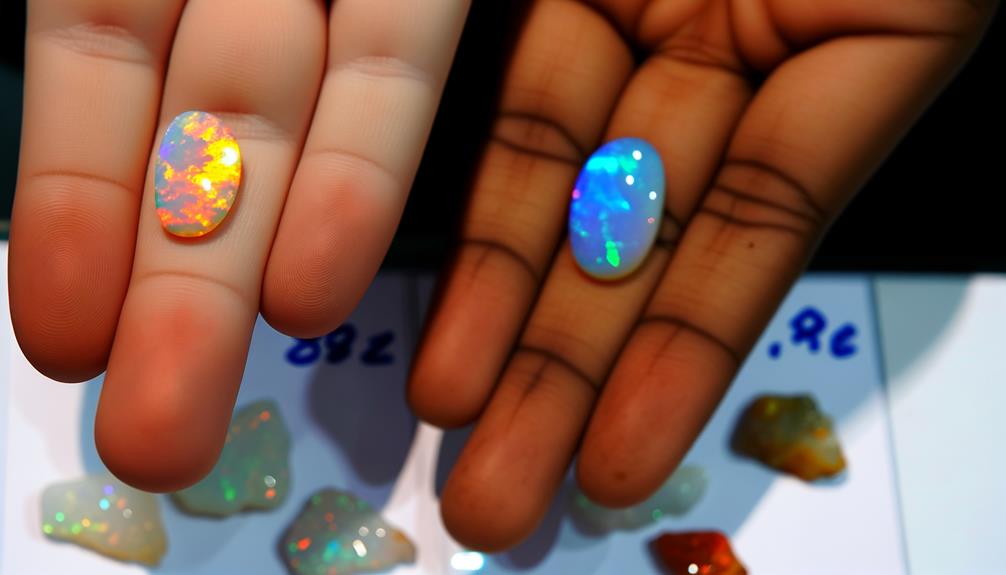
When comparing the market value of Fire Opal to Ethiopian Opal, you should consider price trends, investment potential, and rarity.
Fire Opal often commands higher prices due to its vivid colors and scarcity, while Ethiopian Opal is more abundant but highly sought after for its unique play-of-color.
Analyzing these factors will help you understand their value dynamics and future market potential.
Price Comparison Analysis
The market value of Fire Opals often surpasses that of Ethiopian Opals due to their vibrant color saturation and relative scarcity. When comparing these two gemstones, several factors play essential roles in determining their prices:
- Color Intensity: Fire Opals exhibit a more intense and consistent color spectrum, enhancing their appeal.
- Clarity: Fire Opals generally have fewer inclusions, leading to higher clarity ratings.
- Rarity: The limited geographic sources of Fire Opals make them less common and therefore more valuable.
- Durability: Fire Opals are typically more durable, increasing their desirability and market price.
Understanding these elements helps you grasp why Fire Opals command higher prices in the market compared to Ethiopian Opals.
Investment Potential
Given their higher market prices, Fire Opals often present a more lucrative investment opportunity compared to Ethiopian Opals. Fire Opals have a consistent demand among collectors due to their vibrant colors and rarity. Ethiopian Opals, while beautiful and unique, tend to have more market volatility and less predictable value appreciation.
| Feature | Fire Opal | Ethiopian Opal |
|---|---|---|
| Market Stability | High | Moderate |
| Value Appreciation | Consistent | Variable |
| Investment Risk | Lower | Higher |
When you consider investment potential, Fire Opals offer a more stable and predictable market. They maintain their value better and can appreciate consistently over time. Ethiopian Opals, with greater market fluctuations, present higher risk but can also yield substantial returns under the right conditions.
Rarity and Demand
Fire Opals command higher market value due to their exquisite rarity and consistent demand among gem collectors. These fiery gems, primarily sourced from Mexico, exhibit a vibrant red, orange, and yellow spectrum that captivates enthusiasts.
In contrast, Ethiopian Opals, though stunning, are more abundant and thus less costly.
Consider these key points:
- Rarity: Fire Opals are less common, making them highly sought after.
- Color Play: Fire Opals' intense hues are more uniform compared to the diverse play-of-color in Ethiopian Opals.
- Durability: Fire Opals generally possess greater hardness, enhancing their desirability for jewelry.
- Market Trends: Consistent demand for Fire Opals sustains their higher market value, whereas Ethiopian Opals face fluctuating interest.
Understanding these factors helps you appreciate their market dynamics.
Popular Uses
Many jewelers and designers incorporate fire opals and Ethiopian opals into intricate jewelry pieces, accentuating their unique optical properties. Fire opals, known for their vibrant, fiery hues, are frequently used in rings and pendants where their intense color can be showcased.
In contrast, Ethiopian opals, with their remarkable play-of-color, are often set in earrings and brooches to maximize their iridescent display under varied lighting conditions. Both types of opals are also popular in custom jewelry due to their distinct aesthetic appeal.
You'll find that fire opals are preferred for bold, statement pieces, while Ethiopian opals are favored for their dynamic color play, making them ideal for more versatile and elegant designs.
Care and Maintenance
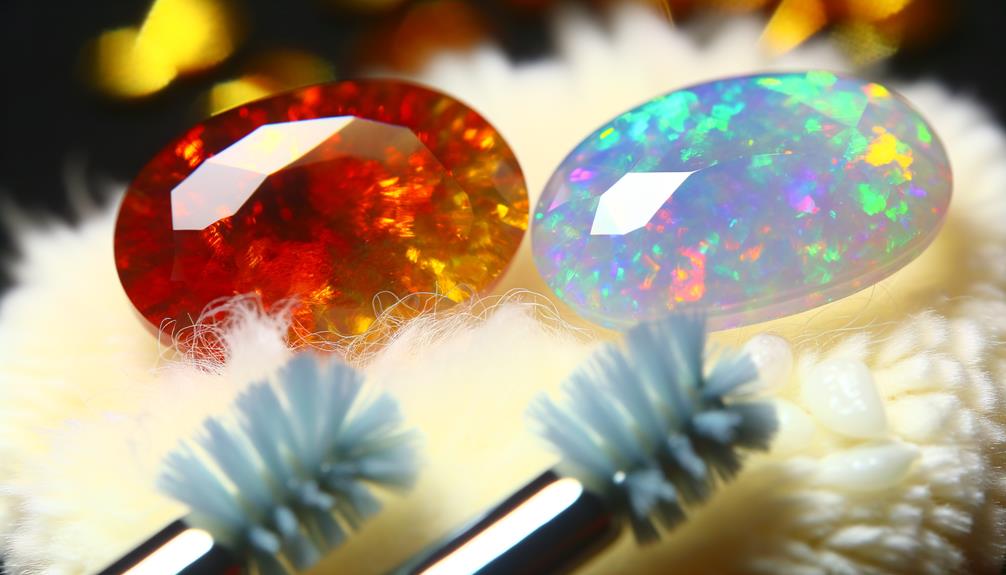
In caring for Fire Opals and Ethiopian Opals, you'll need to understand their distinct cleaning techniques, storage recommendations, and handling precautions.
Fire Opals, with their lower moisture content, require less humidity control compared to the hydrophane nature of Ethiopian Opals.
Both types, however, demand gentle cleaning with mild soap and water, avoiding harsh chemicals to maintain their brilliance and structural integrity.
Cleaning Techniques
Proper care and maintenance are crucial to preserve the brilliance and integrity of both fire opals and Ethiopian opals, given their distinct physical and chemical properties.
Use these cleaning techniques to keep your opals looking their best:
- Mild Soap Solution: Clean both types of opals with a soft cloth dipped in a gentle soap solution. Avoid harsh chemicals.
- Gentle Rinsing: Rinse under lukewarm water. Fire opals are less porous than Ethiopian opals, which absorb water, so be concise.
- Drying: Pat dry with a soft, lint-free cloth. Guarantee Ethiopian opals are completely dry to prevent water absorption.
- Avoid Ultrasonic Cleaners: These can harm both types of opals due to their sensitivity to vibrations and sudden temperature changes.
Storage Recommendations
After cleaning, you must store fire opals and Ethiopian opals correctly to prevent damage and preserve their unique qualities.
Fire opals, being less hydrophilic, require storage in a dry, cool environment, ideally wrapped in a soft, lint-free cloth to avoid scratches.
Conversely, Ethiopian opals, known for their high water content, benefit from a slightly humid environment to prevent dehydration and cracking. You can store them in a sealed plastic bag with a moist cloth to maintain moisture levels.
Avoid exposing both types of opals to extreme temperatures or direct sunlight, as these conditions can compromise their structural integrity and vibrant play-of-color.
Proper storage safeguards your opals' longevity and continued brilliance.
Handling Precautions
When handling fire opals and Ethiopian opals, make sure you avoid sudden temperature changes to prevent thermal shock, which can cause cracking. These opals are highly sensitive to environmental fluctuations.
Key care points include:
- Hydration maintenance: Ethiopian opals, being hydrophane, can absorb water, altering their appearance. Keep them away from prolonged exposure to moisture.
- Avoid harsh chemicals: Both types are vulnerable to damage from household cleaners and perfumes.
- Storage: Store opals separately in a padded container to prevent scratching and impact damage.
- Cleaning: Use mild soap and lukewarm water, avoiding ultrasonic cleaners that can fracture the delicate structure.
Historical Significance
Throughout history, both fire opals and Ethiopian opals have held significant cultural and mystical importance across various civilizations.
Fire opals, found mainly in Mexico, were revered by the Aztecs and Mayans, who believed they contained the essence of fire and used them in rituals and jewelry.
Ethiopian opals, discovered more recently, have swiftly garnered interest due to their unique play-of-color and hydrophane properties. These opals have been linked to ancient African traditions, symbolizing hope and purity.
When comparing the two, fire opals are valued for their vibrant hues and historical resonance in Mesoamerican cultures, while Ethiopian opals are celebrated for their dynamic color patterns and relatively recent yet impactful entry into the gemstone world.
Symbolism and Meaning
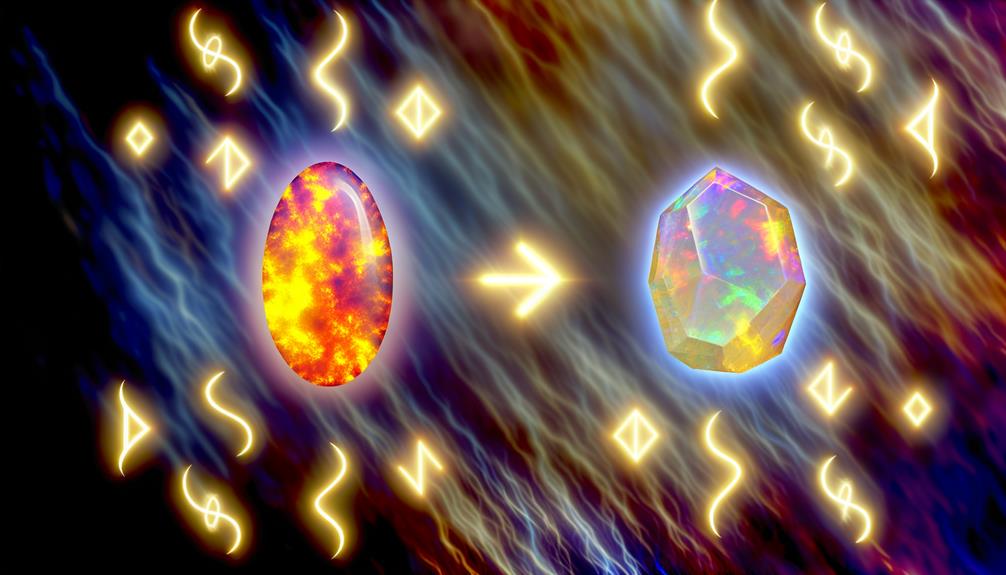
You'll find that Fire Opal is often associated with passion and essential, while Ethiopian Opal symbolizes transformation and protection.
Scientifically, both opals exhibit unique emotional healing properties; Fire Opal is believed to enhance self-confidence, whereas Ethiopian Opal is thought to promote emotional balance.
Analyzing their cultural significance, Fire Opal frequently appears in Mexican folklore, whereas Ethiopian Opal has strong ties to African traditions.
Cultural Significance
Fire opal and Ethiopian opal hold distinct cultural significance, with each gemstone embodying unique symbolism and meaning rooted in their respective origins. Fire opal, originating from Mexico, is deeply associated with passion, energy, and creativity. In contrast, Ethiopian opal, discovered in the Wollo Province, is revered for its vibrant play-of-color, symbolizing purity and hope.
Consider these cultural aspects:
- Mexican Heritage: Fire opal is often linked to Aztec and Mayan traditions, symbolizing the power of the sun.
- Ethiopian Connection: Ethiopian opal is tied to ancient Abyssinian culture, reflecting spiritual insight.
- Resilience: Fire opal is believed to inspire courage and strength.
- Transformation: Ethiopian opal represents transformation and personal growth.
Understanding these facets enriches your appreciation of each gemstone.
Emotional Healing Properties
Understanding the cultural significance of fire opal and Ethiopian opal lays the groundwork for appreciating their distinct emotional healing properties. Fire opal, with its vibrant orange-red hues, is believed to stimulate passion, creativity, and spontaneity. It's often associated with boosting confidence and emotional resilience.
In contrast, Ethiopian opal, characterized by its play-of-color, is linked to emotional intelligence and introspection. It enhances calmness, self-awareness, and the ability to process complex emotions. Scientifically, these properties may relate to the stones' unique light interactions and trace element compositions, influencing your psyche differently.
Famous Specimens
Among the celebrated specimens in the world of opals, the 'Burning of Troy' fire opal and the 'Queen of Sheba' Ethiopian opal stand out for their exceptional color play and historical significance. These specimens are renowned for their unique attributes:
- Burning of Troy: Exhibits a vibrant red-orange hue, symbolizing the legendary city's fiery destruction.
- Queen of Sheba: Known for its vivid, multi-colored play-of-color, reflecting Ethiopia's rich cultural history.
- Gemological Analysis: 'Burning of Troy' shows high transparency and minimal inclusions, while 'Queen of Sheba' displays a broad spectrum of colors due to its hydrated silica composition.
- Historical Relevance: Both are linked to ancient civilizations, enhancing their allure and value.
Buying Tips
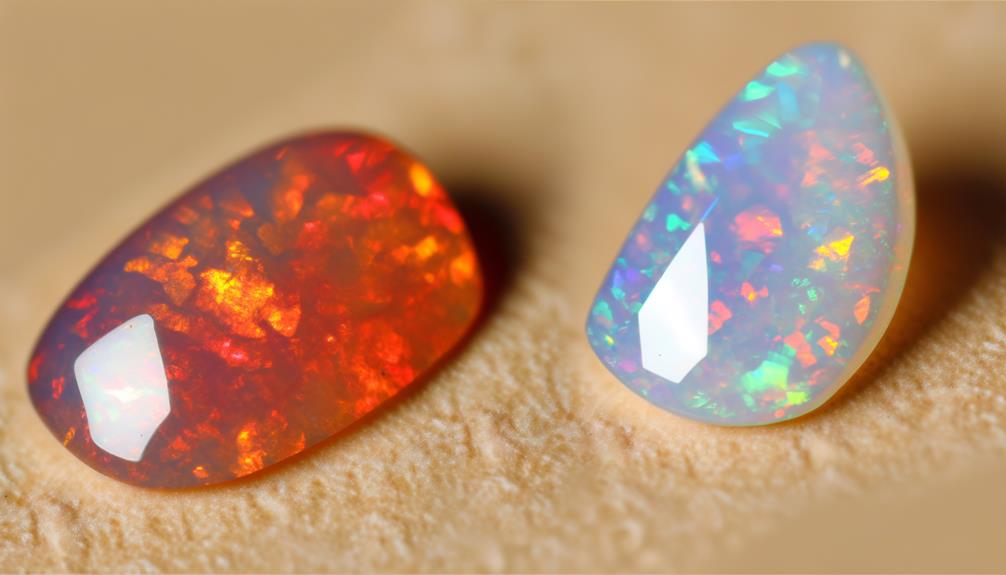
When purchasing opals, particularly fire opals and Ethiopian opals, evaluating factors such as color intensity, transparency, and the presence of inclusions is crucial.
Fire opals often exhibit vibrant hues ranging from yellow to deep red; prioritize stones with uniform color distribution.
Ethiopian opals are renowned for their play-of-color. Inspect them under multiple light sources to confirm this optical phenomenon is prominent.
Transparency varies; fire opals can be more translucent, while Ethiopian opals may range from opaque to transparent.
Inclusions, or internal flaws, can affect an opal's structural integrity and visual appeal. Use a loupe to examine these.
Always verify the opal's origin and request certification to authenticate its quality. These steps are vital for a wise investment.
Conclusion
In comparing fire opal and Ethiopian opal, you've explored their origins, formations, and unique characteristics. Both opals bring their own magic with vibrant colors and enchanting play-of-color.
While fire opal dazzles with its fiery hues, Ethiopian opal enchants with its diverse palette and remarkable clarity. Ultimately, your choice boils down to personal preference and intended use.
Remember, selecting an opal isn't just a purchase; it's an investment in nature's artistry. Happy opal hunting!

